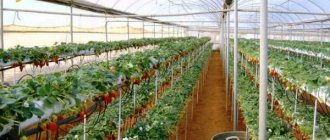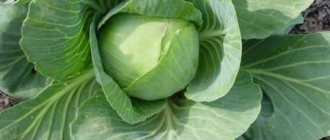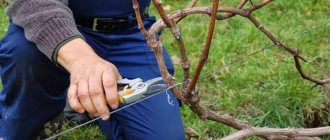Pros of growing in a greenhouse
Cultivating a crop in protected soil has many advantages. When growing in a greenhouse, you don’t have to worry that the grapes won’t have time to ripen before the cold weather sets in, because the climate in the greenhouse can be controlled independently. In addition, even in the south, many winegrowers prefer to grow berries indoors, because this way they can get the harvest much earlier than expected. This is especially true for those farmers who are engaged in entrepreneurial activities and grow grapes for sale. The advantages of greenhouse cultivation also include:
- No problems with harmful insects and diseases - any living creatures rarely enter the greenhouse, including wasps, which often spoil the berries. Diseases such as mildew and oidium appear extremely rarely in greenhouses.
- Plants are protected from adverse weather conditions, be it rain, wind or sun. Grapes grow and develop in static climatic conditions.
- The growing technology is simple. Plant care is convenient. There is no need to additionally treat the bushes with fungicides and insecticides.
- The berries do not crack from precipitation, and the brushes do not fall apart from windy gusts. This allows the gardener to harvest a full harvest in full.
- The taste of the fruit remains at the same level, in no way inferior to ground grapes.
What affects the layout and direction of the rows?
Important! Proper planning of planting grape seedlings allows you to provide a sufficient amount of light and heat, form and grow large clusters with large fruits.
If the scheme is ill-conceived, the development of the vine will be inhibited, the yield will decrease, and caring for the bushes in the rows will be difficult.
The optimal row direction is recommended from north to south. At the same time, seedlings evenly consume light and heat throughout the day. If the rows are located from east to west, the green mass of one row will shade the seedlings of the other row, and the southern side of the rows will receive the most light. In this case, the gap between the planes is left minimal, and the distance between the rows of bushes is reduced.
Variety selection
Almost all varieties are suitable for greenhouse cultivation, but the best productivity is shown by those that have early ripening periods. For the first time, it is preferable to select cold-resistant, highly immune, shade-tolerant varieties that are guaranteed to produce good offspring. Considering the size and height of the greenhouse, it is recommended to give priority to medium-sized and weakly branched varieties.
Table of varieties most suitable for greenhouses:
| Variety name | Growing season | a brief description of |
| Laura | 110-115 days | High yield. Large berries. Great taste. The mass of the bunch is up to 2.5 kilograms. |
| Song (White Miracle) | 110-115 days | The berries are large, with a large proportion of sugar. The color of the fruit is light green. |
| Greenhouse black | 115-125 days | Self-pollinating variety. The taste of the berries is mediocre. Low resistance to fungal diseases. |
| Memory of Dombkowska | 155 days | High-yielding. Has high immunity. Frost-resistant. |
| Arcadia | 115-125 days | Productivity is above average. Cold-resistant down to -21 degrees. Not susceptible to mildew. Compatible with many rootstocks. |
| Moscow sustainable | 130-140 days | Frost-resistant variety (up to -25 degrees). Possesses enviable health. The berries taste good. |
| Russian Korinka | 110-120 days | Vigorous bush. Resistant to mildew, often affected by oidium. Tolerates frosts down to -28 degrees. |
Growing grapes in a greenhouse - how to plant and care
Many gardeners want to start growing grapes. However, climatic conditions may not be suitable for this plant. Difficulties may also arise while caring for it. To avoid these problems, it is recommended to start growing grapes in a greenhouse.
Is it possible to grow grapes in a greenhouse?
Residents of central Russia and southern regions can grow grapes in greenhouse conditions. In the first case, it will be possible to obtain varieties that do not ripen in open ground, and in the second, you can expect a harvest ahead of schedule. Besides this, there are other advantages:
- in a greenhouse, grapes are protected from such natural adversities as sudden changes in temperature, rainy, windy weather, fog;
- berries are saved from attacks by insects and birds;
- in greenhouse conditions, the risk of infection with fungal diseases decreases;
- berries ripened in the shelter do not lose their taste;
- It is much more convenient to care for the plant in the spring and autumn.
For your information! Next to the grapes in the greenhouse, you can grow other crops in rows. These include strawberries, turnips, radishes, and greens. Some gardeners prefer to grow tulips and other flowers.
However, there are also disadvantages to growing grapes in a greenhouse. The gardener will have to spend money on building the greenhouse itself and purchasing seedlings. When constructing, it is important to strictly follow the instructions so that the shelter subsequently provides the plant with the best conditions. You also need to put a lot of effort into caring for the grapes.
Varieties most suitable for growing in a greenhouse
Many varieties of grapes can take root in a greenhouse. According to experienced winegrowers, table varieties that ripen quite early are considered the best for planting in a greenhouse.
- Laura, or Flora. This variety has high yields. The grapes are known for their large bunches weighing up to 1 kg and juicy berries with a slight nutmeg taste. 60-80% of shoots bear fruit. The color of the fruit is pale green. Berries can be oval, oblong or cylindrical. The leaf color is dark green, the bushes are medium in size. The variety is resistant to frost and disease. From the beginning of flowering to fruiting, 110-120 days pass.
- White miracle. The variety has vigorous or medium-growing vines. The clusters are large and cylindrical in shape. The average weight of a bunch of grapes is 0.7–1 kg. At best, the weight can be 1.3-1.5 kg. The variety is considered self-pollinating. The thin-skinned fruits are green-yellow in color. The pulp is fleshy with sourness. Ripe fruits can be stored for a maximum of 2 months. The white miracle copes with frosts down to −25-27 °C. The variety ripens in 105-110 days.
- Transparent. The varietal crop has average growth and simultaneous maturation of young shoots. The plant has cylindrical clusters weighing up to 1.5 kg. The thin-skinned grapes are light amber in color. The pulp is juicy and sweet with the aroma of nutmeg and sage. He doesn’t mind sub-zero temperatures down to −25 °C, like most diseases. Ripening period is 110-120 days.
- Arcadia. The variety has tall bushes and 50-70% fruit-bearing shoots. The weight of a branched bunch can be from 500 g to 2.5 kg. The leaves are colored light green. The heart-shaped or ovoid berry has an average weight of 11 g. The shade of the fruit is honey, amber. The variety ripens after 120 days.
- Kishmish Potapenko. The fruits of the plant are dark blue or black in color. The clusters are cone-shaped, weighing 500 g. The berries are oval in shape. This variety tastes very sweet. Tolerates frosts down to −25 °C and is characterized by average resistance to diseases. Ripens in the second half of August.
Features of greenhouse arrangement
Greenhouses come in gable and hemispherical types. In the second case, the greenhouse is able to cope with a large load of snow. It is recommended for residents of regions with high rainfall. The height of the grape greenhouse should be at least 2.5 m. It is recommended to take care of the presence of a strip-type foundation, which is not deeply buried. It will protect the grape roots from freezing on the surface.
Cellular polycarbonate or oilcloth covering is used as the cladding material. The second option is suitable for greenhouses without heating. The polycarbonate greenhouse is heated using infrared heating devices under the ceiling and a heating cable in the ground. Cheap devices can serve as an alternative.
Note! In the southern regions you can use oilcloth.
The design should be supplemented with transoms for ventilation throughout the roof. In hot weather, this will help maintain a greenhouse microclimate. In addition to the doors located at the ends of the greenhouse, 2 windows would not be superfluous. Transoms equipped with hydraulic cylinders will facilitate automatic ventilation. Fluorescent lamps can cope with insufficient lighting levels.
Planting seedlings in a greenhouse: what you need to know
Before planting, the plant and soil must be prepared. The main stem must enter the closed area. To do this, a hole is created in the lower part of the structure. Greenhouse soil must be heated, in some cases artificially. To develop deep grape roots, dig a trench along the planting site and fill it with a mixture consisting of:
- peat:
- sand;
- loam;
- crushed chalk;
- mineral fertilizers.
Important! In a greenhouse, it is recommended to extend the wire from the top and from the side walls around the perimeter of the roof. It will limit the height and width of the vineyard, and will save you from burns at elevated temperatures. The vine will be attached to it.
It is worth taking care of good drainage or laying pipes.
The vine is first grown in pots to strengthen the roots. You can plant grapes in a greenhouse at any time of the year. The best month for planting is November. Step-by-step planting of seedlings:
- Make holes 40-45 cm deep. The distance between them should be 1.5-2 m.
- Place the seedling in the hole, straightening its roots.
- Cover with soil and water generously.
Important! Mulching is required to protect the soil from drying out. After planting, you need to shorten the side shoots to the first bud and eliminate weak, diseased ones.
Grape growing technology and care
To grow grapes, you need to follow the rules of caring for them.
- Trimming. This procedure is done throughout the year to ensure plant formation and high yield. Secondary shoots, excess inflorescences, clusters and foliage must be removed.
- Treatment. It is also performed throughout the season. In the spring, the bushes are treated with a 3% solution of copper sulfate or Bordeaux mixture until the buds open. The second treatment with nitrafen and water is done after the formation of 5 leaves.
- Watering and fertilizing. Early varieties are watered 2 times in the summer, and mid-ripening and late varieties - 3 and 4 times. In spring, the plant is fed with nitrogen and phosphorus. In autumn, fertilizing with potassium and copper is necessary.
- Preparing for winter. The vine is bent to the ground and covered with film, needles, spruce branches or agrofibre in late autumn after pruning and falling of the leaves.
Important! Pruning tools must be clean to avoid infection.
Problems with fruiting during greenhouse cultivation
It happens that a gardener receives little grape harvest in a greenhouse, and its fruits are small and tasteless. The problem lies in incorrect agricultural practices. Reasons for poor fruiting:
- lack of microelements;
- excessive nitrogen application;
- errors when pruning.
Important! Without fertilizing, the soil is not able to nourish the plant. A lot of nitrogen fertilizers lead to the growth of leaves and shoots, not fruits.
Anyone can grow grapes. This is not as difficult a task as it might seem at first glance. The main thing is to carry out care procedures on time and correctly.
Greenhouse requirements
In a properly equipped greenhouse, all phases of the growing season of a grape plant pass much faster than in open ground, on average by two weeks. Grapes can be grown in unheated and heated greenhouses. In the first case, the harvest can be obtained 3 weeks earlier than usual, in the second - a month.
What should a greenhouse be like:
- The height of the greenhouse structure must be at least 2.5 meters. For private farms, a small room is suitable, while grapes grown for sale require a lot of space.
- The frame must stand on a strong and deep foundation, which will reliably protect the greenhouse soil from soil pests and weeds. You can build a shallow strip concrete foundation.
- A polycarbonate greenhouse is optimal for growing grapes. This material transmits light well and has good thermal insulation. For unheated rooms, film or glass are suitable.
- There should be vents in the upper part for complete ventilation of the room;
- If a heat-loving variety is cultivated, then the greenhouse must be heated using a fan heater or heating radiator. Phytolamps are used for additional lighting.
- In winter, walls (film, glass) must be removed so that the ground can “breathe” oxygen and be saturated with moisture from the snow.
Preparatory work
When growing grapes in protected soil, you need to know one nuance: a grape seedling can be planted outside the greenhouse, but the trunk and vines themselves must be inside it. Therefore, you need to make a hole in the lower part of the greenhouse wall and push the stem into the greenhouse zone, and the part of the plant that remains outside can be covered with earth or grass mulch.
The soil should be thoroughly warmed up, the approximate temperature is 10 degrees Celsius.
To do this, the greenhouse is heated artificially. The soil should be loose, soft, slightly acidic. The required substrate is made up of different parts of peat (3 parts), loamy soil (7 parts), sand (3 parts), crushed chalk or lime (50 grams per bucket of soil), mineral fertilizers (50 grams of nitrogen, 30 grams of superphosphate, 15 grams potassium). The prepared soil mixture is poured into deep holes, into which young seedlings will subsequently be planted (if planting is carried out in a greenhouse). Advice! It is better to carry out preparatory work in the fall.
Organic matter is added at this time so that by spring the soil will completely absorb all the nutrients from it. In the room you need to install trellises in advance, stretch the wire on which the garter will be made. The wire must be placed at a distance of 20 centimeters from the glass to avoid burns to the vine. The distance between the wire rows should be about 20 centimeters.
Features of greenhouse preparation
Before you start planting grape seedlings in a greenhouse at your dacha, it is necessary to carry out preparatory work.
The soil must first be prepared. Grapes love light, fertile soil with good aeration. The substrate is prepared from sand, peat, limestone, loam and fertile soil. It is recommended to add mineral components. The resulting soil mixture is poured into each hole intended for planting. If there are a lot of seedlings, then instead of separate holes, dig a trench of the required depth and width.
To protect the grapevine from burns in hot weather, a wire is stretched horizontally at a distance of 45 cm from the walls and ceiling of the greenhouse. The wire will limit the extension of the branches, and they will not touch the hot partitions of the structure.
DIY trellises
A grape bush, which is characterized by strong growth and branching, needs to be tied to a support. Typically, a trellis is used as a support - several pillars driven along the bed, between which layers of thread are stretched to tie up the vines. In the greenhouse it is permissible to use T-shaped, single-plane and horizontal trellises, which you can make yourself.
Vertical single-plane trellis
The essence of such a trellis is that along the growth of grape bushes, at an equal distance from each other, tall metal pipes or wooden stakes are driven into the ground, between which a wire or strong thread is stretched. The whip is tied to the wire in a horizontal position. The next lash, which is located above the previous one, will be tied in the same way to the top layer of wire, etc.
The distance between the thread wires is 35-40 centimeters - this is the optimal value so that each lash can be well ventilated and illuminated by the sun. A gap of one meter is left between the stakes (or pipes). If you install them a little wider, the thread layer will sag and the branches will fall or break.
Advice!
If the plant is vigorous, then you can equip the cornice with a trellis and plant the grapes on the roof. This solution will increase the usable area of the greenhouse.
Horizontal trellis
The design of such support devices is somewhat different from vertical ones. T-shaped or simply vertical posts are installed along the row, over which wire is pulled along and across the greenhouse. The result is something like a grid or lattice with cell sizes of 30*40 centimeters. The vines are allowed to grow along this lattice (the same method is used in vertical gardening). And although the design turns out to be bulky, it still makes harvesting easier, since during ripening the bunches seem to hang from the ceiling and can be simply removed from the bush.
At what distance from the house can grapes be planted? At what distance should I plant grapes?
Before planting any garden crop, it is necessary to comprehensively study the process of planting and caring for it. Since it is these processes that directly affect what kind of harvest will be obtained in the end. Of course, in this matter, the experience of other gardeners plays an important role. However, practice shows that from year to year they make the same mistakes, the elimination of which can significantly increase the yield. Especially when it comes to grapes.
Immediately before the planting process, you need to carefully plan all subsequent actions, taking into account all the nuances that may affect the growth, development and fruiting of the plant.
Factors of influence
To ensure that the result of your work is pleasant, you should perform the following actions in advance:
- select suitable planting material;
- assess the condition of the soil on the entire site, the degree of its fertility and suitability for planting grapes;
- plan the necessary activities for caring for the bushes and their approximate timing;
- determine the degree of soil moisture and method of watering.
The answers to the tasks posed above will help you correctly determine the distance between future bushes. This value is influenced by many nuances that should not be underestimated. Even if you want to plant a few bushes in your dacha as a test, you shouldn’t plant them at random. Yes, with a successful combination of circumstances, even randomly planted bushes bear fruit. But if all necessary conditions are met, their quantity and quality will certainly increase. If the results obtained are unsatisfactory, the plants cannot be replanted.
There is only one way to correct the picture - by removing bushes one after another, thereby the distance between neighboring bushes can be increased, but the area will be wasted. Otherwise, you will have to uproot the plantings and start all over again, spending a lot of time and effort, almost in vain.
Purchasing seedlings
Both self-rooted and grafted seedlings are suitable for greenhouse cultivation. But no matter what pedigree the plant has, it must have a healthy and, most importantly, strong root system. The more roots, the faster and better the seedling will take root. If you cut off part of the root, the cut area should be white and moist. Dry, spotted, deformed roots will indicate that the plant is at the stage of death.
The trunk should be smooth, clean, and brown in color. If you slightly move the wood fibers apart, you can see a moist greenish area underneath, indicating the youth and health of the seedling. There should be no husks on the kidneys.
Which seedlings are not advisable to buy:
- if the root system is of an open type, that is, it is not in a moist substrate. In the air, the roots quickly dry out, deteriorate, and die;
- if there is foliage on autumn seedlings. The foliage takes over the strength of the plant, which thus will not survive until spring.
- if at least one bush with signs of disease is noticed among the seedlings sold. Most likely, most of the neighboring seedlings have already become infected.
How to grow
Only with proper observance of all the rules for caring for grapes in a greenhouse will you be able to obtain a bountiful harvest and high quality berries.
Watering
Next, watering should be done when the seedling is in the active growth phase. Do the procedure once a week, using warm and settled water. Water for a month. Then watering is reduced to once every 2 weeks. Often, watering can be combined with the application of fertilizers. For every 10 liters 25 g of mineral supplements. It will also be useful to learn about how to plant and how to care for Aleshenkin grapes.
Top dressing
These events must be carried out 4 times per season. Fertilize first in the spring. To do this you will have to use the following components:
- Superphosphate – 40 g;
- Potassium – 30 g;
- Nitrogen – 55 g.
To 20 liters of water you can add 100 g of a liquid mixture, for example Mortar. It is applied 14 days before the plant blooms. Sometimes you can combine it with organic matter. Apply fertilizing a third time at the stage of berry formation.
But the latter is used when the grapes ripen. To do this, you need to use phosphorus and potassium fertilizers. For foliar feeding, Kemir, Aquarin and Novofert have proven themselves to be excellent. Use them 3-4 times per season. But what are the features of growing Augustine grapes can be learned from this video.
Trimming
Grapes grown in a greenhouse must be pruned and pinched. In the summer, cut shoots that do not bloom to the 5th leaf, and those that bloom - to the second. Remove damaged and weak branches and pinch the top. As soon as the harvest is over, in the fall, make the main shoots shorter by 1⁄2, and leave 2 buds on the stepsons.
Pollination
It is necessary to involve bees in this process, but if they rarely fly into the greenhouse, then it is quite possible to pollinate the grapes on their own. To do this, shake the branches of the culture once a day. Perform the manipulation in the first half of the day.
Shelter
When growing grapes in a greenhouse, shelter is not necessary. But here you need to rely on climate and temperature conditions. If the greenhouse is not heated at the end of October, then before the onset of frost, remove the vine from the trellis, lay it to the ground and cover it with spruce branches, branches or a blanket. If the greenhouse has a removable roof, then the covered grapes will be able to survive the winter in the open air.
Video shows how to properly care for grapes:
Pests and diseases
To obtain a stable and rich grape harvest, it is necessary to create reliable protection for the grapes from parasites and diseases. The main diseases include:
- Gray rot;
- Rubella;
- Mildew;
- Anthracnose;
- Oidium.
But the most dangerous parasites for grapes remain such parasites as mites, bunch budworms and phylloxera. They can only be controlled with the help of insecticides and fungicides. But you shouldn’t get too carried away with them, since they have the ability to accumulate in the soil, which will ultimately have a detrimental effect on the yield and quality of the grapes.
But what the northern sweet grape variety looks like, and how difficult it is to grow it at home, is described here in the article.
Physical methods can also be used to control pests. Its essence is to collect parasites from the vine and then destroy them. This method is quite labor-intensive, but environmentally friendly.
Planting grape seedlings
You can plant annual seedlings or rooted cuttings in early spring, when the greenhouse air and soil have warmed up sufficiently. It is necessary to leave a space of 30-40 centimeters from the wall of the greenhouse to the place where the seedlings are planted.
Planting grapes in stages:
- For seedlings, separate deep holes measuring 50*50 centimeters are dug. Depth – 70 centimeters. The distance between the pits is 50-70 centimeters.
- The bottom of the pit is drained with broken bricks, crushed stone, and expanded clay. The drainage layer is 20-25 centimeters.
- Garden soil mixed with humus, minerals, sand (or peat), and ash is poured on top. The layer is compacted.
- A thick pipe for watering is stuck at the edge of the hole. Its height above the ground should remain at 10 centimeters.
- A small mound is placed at the bottom in the center, on which the seedling is placed in a vertical position. The roots are straightened along the mound so that they look exclusively down.
- The soil is backfilled.
- The soil is compacted from above and watered.
Note!
After the pits for the seedlings have been prepared, it is necessary to install trellises, and only then plant them.
Planting grape seedlings in the ground. Types of spring planting of grape seedlings
Grape bushes are planted individually on individual supports or in rows on common supports. To create a general support, before planting, 2-meter pillars are driven into the soil to a depth of 60 cm at a distance of 2.5 - 3.5 m from each other. A wire is pulled between them at a height of 40 cm from the ground. 2 more wires are pulled over it every 30 cm, crossing them between the pillars. Support slats are inserted between the wires according to the number of grape bushes.
In covered areas, the head of self-rooted seedlings and the junction of grafted ones should be located 2–3 cm below the soil level, and in non-covered areas – just above the ground surface. In regions with cold climates and little snowy winters, it is recommended to deepen the heel of the seedling by 50–60 cm to reduce the risk of grapes freezing.
1. Hydromechanical landing method. It is advisable to use this type of grape planting in medium and large vineyards. Planting is carried out using special grape-planting machines. They consist of a tank with a pump and hand-held hydraulic drills, which are connected to the tanks with rubber hoses. The tank is filled with water. The pump creates a pressure of 1.5 - 2 atmospheres in it, as a result of which water flows to the hydraulic drills. A powerful jet punches planting holes of the required depth in the soil. The slurry filling the wells provides favorable conditions for the rooting of seedlings.
With hydromechanical planting, the traditional method of applying fertilizers is impossible. Therefore, mineral fertilizers are dissolved in tank water. Add 80 g of each fertilizer to 100 liters of water.
The grape bushes are placed in wells and covered with soil, making mounds 1–2 cm high above the seedlings. They protect the grapes from drying out.
2. Manual planting. This is the traditional planting method. A round hole is dug or drilled in the center of the prepared planting hole. Its depth depends on the parameters of the seedling and consists of the length of the seedling itself, the length of its roots and a 15-centimeter “reserve”. A mound of fertilized soil is poured into the bottom of the hole or a mixture of humus, ash, sand and fertile soil is prepared in it, diluting it with water to the consistency of liquid sour cream.
When planting an annual seedling, it is installed by holding the ends of the roots with your hand and straightening them to the bottom of the hole. If everything is done correctly, the root system will grow as needed, and no voids will form between the roots.
When planting a vegetating seedling, carefully, so as not to damage the roots, cut the packaging (bottle, polyethylene) and take the seedling out of it along with a lump of earth. This must be done in such a way as not to destroy the lump or tear the thin roots of the grapes. The seedling is taken by the lower part and immersed in the hole of the planting hole in the same way as a one-year-old seedling.
The seedlings are covered with earth. First, the hole is filled halfway, the earth is trampled underfoot and watered with warm water. Then the hole is filled to the brim. The top of the soil is mulched with sand, dry soil or sawdust so that moisture evaporates more slowly. You can additionally cover the planting site with plastic film.
Plantings are covered to protect them from autumn or spring frosts.
Care
Caring for young and then fruit-bearing grapes comes down to systematic watering, formation of shoots, and control of the microclimate. The environment should be comfortable for the crop - the growth of the grape bush will depend on the temperature, amount of sunlight and looseness of the soil.
Features of watering
Greenhouse grapes are watered less often than ground grapes, since the moisture in the greenhouse remains in the soil longer. For the first time, the bush is watered immediately after planting. Then, as soon as it is well rooted, watering is carried out once every 7-10 days, as the top layer of soil dries. During the period of flowering and fruit ripening, the plant requires less moisture. From early July to mid-August, the plant is watered once every two weeks.
Important!
Good ventilation is important for grapes, as they do not tolerate waterlogging.
Temperature
For grapes growing in protected soil, it is important to maintain a suitable temperature. At the time of planting, the temperature in the greenhouse should be an average of +10 degrees. Then the temperature is gradually increased, reaching +24 degrees by the time the buds open. At night, the plant needs +16-18 degrees. When fruit ovaries appear and the crop begins to ripen, the temperature can rise to +30 degrees - this is the optimal indicator for a grape plant.
By controlling the microclimate of the room, it is important to prevent stuffiness, the accumulation of water condensation on the leaves and stems, and the appearance of an earthen crust. During hot days, it is better to shade the greenhouse with a protective awning, otherwise the berries will begin to wither before they have time to ripen.
Note!
The temperature value depends primarily on the grape variety.
Trimming Features
Grapes can be grown along the eaves of the roof. Then it is better to lead the plant in one stem, and pinch the second, spare one. If the greenhouse is not too high, then the grapes can be placed along the wall, forming them in the form of a multi-armed cordon. The essence of pruning greenhouse grapes is that it will remove all the extra shoots that grow during the season, which in a limited space quickly thicken the bush and cast a shadow on the fruits.
In cases where other crops grow next to a grape bush, it is given a standard form. Standard grapes can even be grown in a pot. The plant produces few clusters, but they are of high quality and very good taste.
Formation begins immediately after planting the seedling. Initially, the trunk is severely pruned, and in subsequent years all regrown shoots are shortened by half, cutting off all unripe green areas. To prevent side shoots from growing too quickly, they are pinched in the summer and removed during autumn pruning. The height of the trunk can be up to one meter. Higher up the growth of lateral branches begins. The crown is formed in such a way that up to two buds remain on each shoot during autumn pruning. All side stepsons are completely removed. Gradually, the main short strong branches will form on the bush. In summer, stems will grow from these branches, which are trimmed as soon as they reach 40 cm in length.
To obtain larger berries and voluminous bunches, it is necessary to free the shoots from excess fruit ovaries, otherwise there will be a lot of clusters, but they will grow small and loose. Removing small fruits, weak branches, dried and yellowed leaves will help prevent overload.
Help with pollination
Self-pollinating grape varieties, that is, those whose flowers have organs of both sexes, are optimally suited for the greenhouse. This approach is due to the fact that pollinating bees rarely enter the greenhouse, and therefore pollination may not occur, and therefore there will be no harvest. If you cultivate a bee-pollinated variety, you will have to carry out pollination yourself. When the flowers are fully open, you need to tap the branches or flowers so that the pollen from the male flowers falls onto the female ones. To ensure efficiency, a fan is installed in the greenhouse to spread pollen by the wind.
Top dressing
In the first year after planting, grapes do not need fertilizing. But this is provided that the land was generously fertilized when the beds were planted. Otherwise, the crop needs fourfold application of fertilizers:
- In the spring. Organic matter in the form of ammonium nitrate or urea, potassium salt, and superphosphate are added into trenches 25 centimeters deep dug next to the bush. The share of nitrogen fertilizers at this stage should be 45%, the share of potassium fertilizers – 25%, the share of phosphorus fertilizers – 30%.
- Two weeks before flowering. This time the land is supplied with organic matter (diluted mullein, compost, chicken droppings), 20 grams of potassium sulfate and 25 grams of superphosphate diluted in water.
- The appearance of berries. Carry out foliar feeding with microelements.
- Ripening of berries. The share of phosphorus and potassium fertilizers is doubled. Nitrogen is completely excluded. Wood ash can replace potassium at this stage.
Shelter for the winter
After harvesting, final watering is carried out at the end of September. Moisture will nourish the roots in winter. The vines are removed from the trellises and dug trenches are laid - this will provide the wood with warmth and prevent frostbite. The top of the shoots is covered with spruce branches, straw, dry grass, and sawdust. You can spray the bushes with insecticides and fungicides in advance to prevent the disease from occurring.
It is better if the walls and roof of the greenhouse are removed. In this case, the frame must be disassembled so that the snow creates a reliable protective layer for the grape vines.
By the way!
For the winter, grapes can be covered with non-woven material, for example, roofing felt, agrofibre.
Watering and fertilizing
To get a good harvest of grapes, you need to properly care for them , follow the rules of fertilizing and watering the plant.
Irrigation features:
- The first watering is carried out immediately after planting.
- Then, to maintain optimal soil moisture, young bushes are watered once every 6-7 days.
- During the flowering period, watering is suspended, as well as during the formation of berries. Excessive humidity will negatively affect the quality of the crop.
- Please note that greenhouse grapes are not watered in the evening. Excess moisture in the air will cause the berries to crack.
Fertilizer application:
- use nitrogen fertilizers with extreme caution;
- before planting, it is advisable to apply organic fertilizers;
- during bud break, you can apply ammonium nitrate for good leaf development and bud formation, and before flowering - superphosphate;
- During further growth, only foliar fertilizers are applied. Superphosphate and ash are used after the end of the flowering period.
Problems with fruiting
Often a gardener is faced with the problem of fruiting - the grapes produce a very meager harvest, and the fruits are small and not sweet. Most often, the problem lies in incorrect agricultural technology.
Why grapes don’t bear fruit in a greenhouse:
- there are not enough microelements - if fertilizing is not done in a timely manner, the soil is quickly depleted and ceases to fully nourish the plant. If the grapes do not have enough zinc, manganese, boron and other chemical elements, their development will slow down, flowering and fruiting will be weak;
- excess nitrogen - it is important to remember that applying nitrogen-containing fertilizers is advisable only at the first stage of the growing season. During flowering and ripening of berries, an excessive dose of nitrogen can provoke the growth of shoots and leaves, but not fruits;
- flaws in pruning - infrequent or incorrect pruning leads to thickening of the crown, peas, and overloading of shoots with fruits.
Landing Features
The technology of growing grapes in a greenhouse includes a number of rules:
- young bushes begin to be planted at the end of winter;
- The scheme for planting grapes in a greenhouse is as follows: a deep and wide hole (at least 35-40 cm) is dug for planting. At the bottom of the hole in the center you can make a small mound (as when planting an apple tree), place the seedling vertically in the center, straighten the roots, cover it with soil, lightly compact it and water it;
- Before planting, it is advisable to apply organic fertilizers (compost, overripe manure).
- pay attention to the distance between the seedlings, which should be at least 50-65 cm. This is the only way the vine will receive enough free space to develop and form the main stem.
- do not forget to inspect the appearance of young bushes and roots before planting. The plant must be healthy and strong.
Rules for growing greenhouse grapes in the Moscow region
The weather in the central region of the country is changeable. Frequent temperature changes, precipitation, cold snaps, days of heat - all this affects the growth of grapes and their productivity. Therefore, in the Moscow region the crop is also grown in greenhouses.
Basic principles of cultivation:
- It is recommended to choose early, medium-growing grape varieties such as Kishmish (seedless);
- It is better to use a wall-mounted version of the greenhouse, that is, one wall is replaced by a house wall, which adds warmth to the greenhouse space. The open parts of the greenhouse should face the south and southwest sides;
- For irrigation, it is preferable to use a drip irrigation system;
- since the soil is often too acidic, when making up a soil mixture for a greenhouse, chalk powder is added to the soil (loam), sand, peat;
- seedlings are planted in the greenhouse in February. The greenhouse must be heated until mid-March.
Grape varieties and planting in greenhouse conditions
The best grape varieties for cultivation in a greenhouse are early varieties. Residents of central Russia are recommended to plant the following varieties:
- Michurinsky;
- Northern early;
- Russian Korinka;
- Moscow sustainable.
In the Urals, the following varieties take root well in greenhouse conditions:
- Black Hamburg;
- The delight is perfect;
- Foster (white variety);
- Bulgaria is resilient;
- Precocious Parlette.
Also suitable for cultivation in a greenhouse are varieties with the names:
- Leah;
- Bazhena;
- Madeleine;
- Prometheus;
- Helios;
- Gorgeous;
- Arcadia;
- Zest;
- Gourmet early;
- New century;
- Arched grapes;
- Queen of the Vineyards.
If the vine originally grew in a pot, it can be transplanted into a greenhouse in any month (preferably November or December). At the same time, the first pruning is carried out. Plants are placed along the side walls with a distance of 50–80 cm. Seedlings must be separated from their “neighbors” by a distance of at least 1 m.
Grapes are planted in a greenhouse according to a certain technology.
- They dig holes with a diameter that allows the root system to fit comfortably.
- The rhizome of grapes, previously grown in a pot, is completely spread around the entire perimeter of the hole.
- The holes are covered with earth and watered abundantly.
- The vine is mulched, that is, the soil surrounding it is covered with black film. A greenhouse effect is created under it and moisture is better retained.
In a small greenhouse, the vine should be rooted away from the entrance, for example, in the far corner. The optimal location is along the perimeter of the room. The shoots should stand vertically. In the 2nd half of May, the roof of the greenhouse is shaded.
Rules for growing greenhouse grapes in Siberia
The climate of the northern part of the country is more severe than that of the Moscow region. Summer there is cooler and shorter, frosts begin in early September, and spring comes late. Therefore, growing grapes there is somewhat more difficult.
Basic principles of cultivation:
- the greenhouse must be heated;
- for the Siberian climate the most suitable varieties are: Arcadia, Laura, Aleshenka, Transparent;
- The top soil layer should be loose and light, since it is in it that the roots take root. It is made up of turf soil, sand and gravel;
- After planting, the plantings are mulched so that the roots are always warm. The mulch layer can be made of compost or straw. The number of waterings is significantly reduced;
- With the appearance of the first flower buds, root fertilizing with saltpeter is carried out. It can be arranged 2-3 times with an interval of two weeks;
- After flowering, the ground is dusted with wood ash, which acts as a prophylactic against fungal infections.
Rules for growing greenhouse grapes in the Urals
The climate of the Urals is close to the northern one. It also experiences cold winters and short, warm and humid summers. Since mid-summer, fungal infections have been rampant in the region. This is due to excessive soil moisture due to frequent precipitation.
Basic principles of cultivation:
- Mostly seedless varieties are suitable for the greenhouse, such as Korinka Russian, Rusbol (raisin), Hybrid-342, Pamyat Dombkovskaya, Irinka;
- The soil at depth is often clayey. Therefore, before planting seedlings, deep holes are dug and the bottom is covered with a mixture of rotted manure, mineral fertilizers and fertile turf soil;
- grape bushes are regularly treated with contact fungicides to protect against mildew and oidium. Although this disease is extremely rare in protected soil, it is still better to take additional measures to protect plants from the insidious disease, which often appears “out of nowhere”;
- For the winter, the grapes are removed from the trellises and covered with spruce branches. You can fill the bases of the bushes with earth or sand. And neatly twisted flexible vines are covered with agrospan;
- in the fall, after harvesting, the grape bushes are fed additionally with potassium fertilizers. This is necessary to increase the immunity of plants and their better wintering.
Grape growing technology and care
To grow grapes, you need to follow the rules of caring for them.
- Trimming. This procedure is done throughout the year to ensure plant formation and high yield. Secondary shoots, excess inflorescences, clusters and foliage must be removed.
- Treatment. It is also performed throughout the season. In the spring, the bushes are treated with a 3% solution of copper sulfate or Bordeaux mixture until the buds open. The second treatment with nitrafen and water is done after the formation of 5 leaves.
- Watering and fertilizing. Early varieties are watered 2 times in the summer, and mid-ripening and late varieties - 3 and 4 times. In spring, the plant is fed with nitrogen and phosphorus. In autumn, fertilizing with potassium and copper is necessary.
- Preparing for winter. The vine is bent to the ground and covered with film, needles, spruce branches or agrofibre in late autumn after pruning and falling of the leaves.
Important! Pruning tools must be clean to avoid infection.
Grape pruning
Reviews
Marina
I live in the Western Urals. I prefer to grow the varieties Alyoshechki, Pamyat Dombkovskaya, and Isabella on my plot. These varieties are considered unpretentious and productive. The variety Pamyat Dombkowska has small clusters, but there are always a lot of them. The taste of the berries is excellent. Isabella is a wonderful wine variety. I plant seedlings in a hole, two at a time. I leave the distance between the holes small, about 60 centimeters, since the greenhouse is small. The greenhouse faces south, so the grapes are always illuminated by the sun's rays, and the vines always ripen on time. I always insulate the plantings for the winter, although I don’t remove the greenhouse.
Oleg
I have been growing grapes in protected soil for several years now. I like this method of cultivation because the crop in this way is almost never affected by disease. Everyone also knows that grapes do not tolerate excessive humidity. Well, in the greenhouse this does not threaten him, which means there will be no rot or mold. I am also satisfied with the yield - any variety in a greenhouse always shows excellent productivity, even with little care. And the taste of the berries is no worse than that of grapes grown in open ground. In general, greenhouse grape growing has some advantages.











